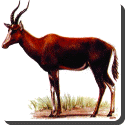 Blesbok — The Blesbok, or Blesbuck, (Damaliscus dorcas phillpsi) is related to the Bontebok (Damaliscus dorcas dorcas)and it is purplish antelope with a distinctive white face and forehead. Although they are close relatives of the Bontebok and they can interbreed creating an animal known as the Bontebles they do not share habitat, the Bontebok being found in large numbers on from as far south as Eastern Cape, the plains of the Free State and the Transvaal Highveld. They are a plains species and dislike wooded areas. The blesbuck is indigenous to South Africa and are found in large numbers in all national parks with open grasslands. They were first discovered in the 17th century, and were found in numbers so numerous that herds that reached from horizon to horizon where documented.
Blesbok — The Blesbok, or Blesbuck, (Damaliscus dorcas phillpsi) is related to the Bontebok (Damaliscus dorcas dorcas)and it is purplish antelope with a distinctive white face and forehead. Although they are close relatives of the Bontebok and they can interbreed creating an animal known as the Bontebles they do not share habitat, the Bontebok being found in large numbers on from as far south as Eastern Cape, the plains of the Free State and the Transvaal Highveld. They are a plains species and dislike wooded areas. The blesbuck is indigenous to South Africa and are found in large numbers in all national parks with open grasslands. They were first discovered in the 17th century, and were found in numbers so numerous that herds that reached from horizon to horizon where documented.
The neck and the top of the back of the blesbuck are brown. Lower down on the flanks and buttocks, the coloring becomes darker. They belly, the inside of the buttocks and the area up to the base of the tail are white. Blesbucks can be easily differentiate from other antelopes because they have a distance white face and forehead. The legs are brown with a white patch behind the top part of the front legs. Lower legs whitish. Both sexes have horns, female horns are slightly more slender. The blesbok differs from the bontebok by having less white on the coat and the blaze on the face, which is usually divided, their coats are also a lighter brown than that of the bontebok. The length of their horns averages at around 38cm. Male adult blesboks average around 70kg, females average lower, at around 61kg.
 Kids Portal For Parents India Kids Network
Kids Portal For Parents India Kids Network






